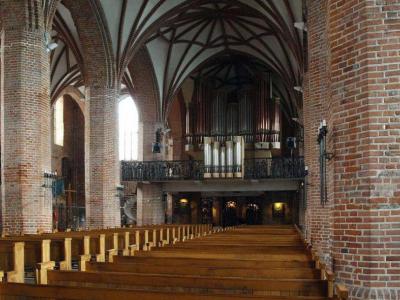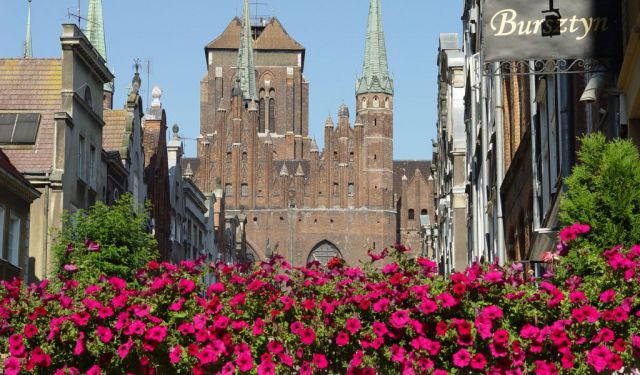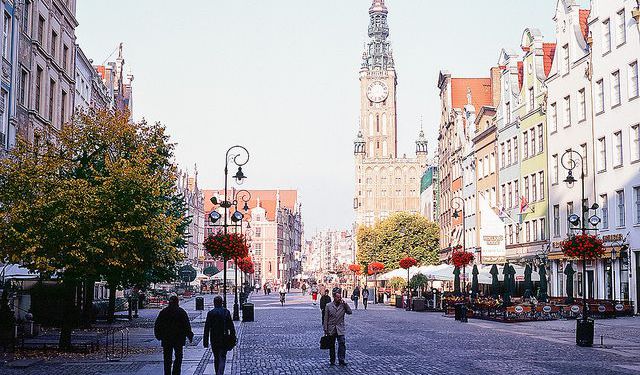St. Bridget's Church, Gdansk
Saint Bridget's Church in Gdansk is an important historical and cultural site deeply connected to Polish history and the Catholic religion. First built in the late 14th century for Saint Bridget's Order followers, the church has a significant past. It was almost entirely destroyed during World War II and was reconstructed in 1973 using its original 1394-1420 designs. This rebuild maintains the church's original architectural style and its historical importance.
The church's standout feature is the 'Amber Altar', a continuing project that honors Divine Providence, celebrates Pope John Paul II's papacy, and acknowledges Poland's regained independence. This altar is a religious symbol and an artistic masterpiece, displaying the Blessed Virgin Mary, painted by Father Franciszek Znaniecki, influenced by the December 1970 workers' massacre. It includes figures like Saint Bridget of Sweden, Saint Elizabeth Hesselblad, Pope Saint John Paul II, and Cardinal Stefan Wyszynski, showing the blend of Polish patriotism and Catholic faith. The altar also has an amber monstrance with relics of Pope Saint John Paul II and Blessed Jerzy Popieluszko, adding to its historical and religious value.
The church also features memorials to various historical events, like the Katyń massacre and tributes to Solidarity (Solidarność), a broad anti-authoritarian social movement, showing the strong link between the Catholic Church and Polish nationalism. One memorial is for Father Jerzy Popieluszko, a Solidarity chaplain killed by secret police in 1984.
In 2010, renovation works uncovered a hidden crypt with human remains, believed to be from the early 17th century. Now open to the public, this crypt contains Saint Bridget of Sweden's relics and some of the found skulls, adding more to the church's rich history.
Finally, the church's recognition as a Lesser Basilica in 1991 by Pope John Paul II and his statue outside highlight its religious significance and its ties to the broader Catholic community. Saint Bridget's Church is more than a place of worship; it's a symbol of Polish history, faith, and endurance.
The church's standout feature is the 'Amber Altar', a continuing project that honors Divine Providence, celebrates Pope John Paul II's papacy, and acknowledges Poland's regained independence. This altar is a religious symbol and an artistic masterpiece, displaying the Blessed Virgin Mary, painted by Father Franciszek Znaniecki, influenced by the December 1970 workers' massacre. It includes figures like Saint Bridget of Sweden, Saint Elizabeth Hesselblad, Pope Saint John Paul II, and Cardinal Stefan Wyszynski, showing the blend of Polish patriotism and Catholic faith. The altar also has an amber monstrance with relics of Pope Saint John Paul II and Blessed Jerzy Popieluszko, adding to its historical and religious value.
The church also features memorials to various historical events, like the Katyń massacre and tributes to Solidarity (Solidarność), a broad anti-authoritarian social movement, showing the strong link between the Catholic Church and Polish nationalism. One memorial is for Father Jerzy Popieluszko, a Solidarity chaplain killed by secret police in 1984.
In 2010, renovation works uncovered a hidden crypt with human remains, believed to be from the early 17th century. Now open to the public, this crypt contains Saint Bridget of Sweden's relics and some of the found skulls, adding more to the church's rich history.
Finally, the church's recognition as a Lesser Basilica in 1991 by Pope John Paul II and his statue outside highlight its religious significance and its ties to the broader Catholic community. Saint Bridget's Church is more than a place of worship; it's a symbol of Polish history, faith, and endurance.
Want to visit this sight? Check out these Self-Guided Walking Tours in Gdansk. Alternatively, you can download the mobile app "GPSmyCity: Walks in 1K+ Cities" from Apple App Store or Google Play Store. The app turns your mobile device to a personal tour guide and it works offline, so no data plan is needed when traveling abroad.
St. Bridget's Church on Map
Sight Name: St. Bridget's Church
Sight Location: Gdansk, Poland (See walking tours in Gdansk)
Sight Type: Religious
Guide(s) Containing This Sight:
Sight Location: Gdansk, Poland (See walking tours in Gdansk)
Sight Type: Religious
Guide(s) Containing This Sight:
Walking Tours in Gdansk, Poland
Create Your Own Walk in Gdansk
Creating your own self-guided walk in Gdansk is easy and fun. Choose the city attractions that you want to see and a walk route map will be created just for you. You can even set your hotel as the start point of the walk.
Solidarity Union Walking Tour
For decades, the word 'Solidarity' (Polish: Solidarność) has been synonymous with the city of Gdansk. The peaceful Solidarity revolution, started here in the August of 1980, marked the outset of the fall of communism not only in Poland but also throughout Eastern Europe.
Stemmed from the country's first free labor union born out of strikes at the Lenin Shipyard (now the Gdansk... view more
Tour Duration: 1 Hour(s)
Travel Distance: 0.8 Km or 0.5 Miles
Stemmed from the country's first free labor union born out of strikes at the Lenin Shipyard (now the Gdansk... view more
Tour Duration: 1 Hour(s)
Travel Distance: 0.8 Km or 0.5 Miles
Gdansk's Historical Churches Tour
Gdansk has a long history of Catholicism, hence the abundance of spectacular churches here. Let's delve into some of the most impressive temples that grace the cityscape and see what they are.
Saint John's Church, a Gothic masterpiece, stands tall in the heart of Gdansk. It dates back to the 14th century and features impressive brickwork and intricate details. Its towering spire is a... view more
Tour Duration: 1 Hour(s)
Travel Distance: 1.6 Km or 1 Miles
Saint John's Church, a Gothic masterpiece, stands tall in the heart of Gdansk. It dates back to the 14th century and features impressive brickwork and intricate details. Its towering spire is a... view more
Tour Duration: 1 Hour(s)
Travel Distance: 1.6 Km or 1 Miles
Gdansk Introduction Walking Tour
The most probable source for the name, "Gdansk" seems to be "Gdania", the ancient name of the river Motlawa. Gdansk began with agriculture and fishing and trade with Pomerania in the 9th century. It was annexed by Mieszko, Duke of Poland, in 975.
The center of town was the Long Market, with its craftsmen. German merchant settlements grew by St Nicholas Church. Gdansk joined... view more
Tour Duration: 2 Hour(s)
Travel Distance: 2.2 Km or 1.4 Miles
The center of town was the Long Market, with its craftsmen. German merchant settlements grew by St Nicholas Church. Gdansk joined... view more
Tour Duration: 2 Hour(s)
Travel Distance: 2.2 Km or 1.4 Miles






